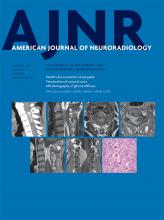Index by author
Kim, J.H.
- Head and Neck ImagingYou have accessDiffusion-Weighted Imaging of the Head and Neck: Influence of Fat-Suppression Technique and Multishot 2D Navigated Interleaved AcquisitionsY.J. Bae, B.S. Choi, H.-K. Jeong, L. Sunwoo, C. Jung and J.H. KimAmerican Journal of Neuroradiology January 2018, 39 (1) 145-150; DOI: https://doi.org/10.3174/ajnr.A5426
Kim, S.G.
- EDITOR'S CHOICEHead and Neck ImagingOpen AccessDynamic Contrast-Enhanced MRI–Derived Intracellular Water Lifetime (τi): A Prognostic Marker for Patients with Head and Neck Squamous Cell CarcinomasS. Chawla, L.A. Loevner, S.G. Kim, W.-T. Hwang, S. Wang, G. Verma, S. Mohan, V. LiVolsi, H. Quon and H. PoptaniAmerican Journal of Neuroradiology January 2018, 39 (1) 138-144; DOI: https://doi.org/10.3174/ajnr.A5440
The authors evaluated 60 patients with dynamic contrast-enhanced MR imaging before treatment. Median, mean intracellular water molecule lifetime, and volume transfer constant values from metastatic nodes were computed from each patient. Kaplan-Meier analyses were performed to associate mean intracellular water molecule lifetime and volume transfer constant and their combination with overall survival and beyond. Patients with high mean intracellular water molecule lifetime had overall survival significantly prolonged by 5 years compared with those with low mean intracellular water molecule lifetime. Patients with high mean intracellular water molecule lifetime had significantly longer overall survival at long-term duration than those with low mean intracellular water molecule lifetime. Volume transfer constant was a significant predictor for only the 5-year follow-up period. They conclude that a combined analysis of mean intracellular water molecule lifetime and volume transfer constant provided the best model to predict overall survival in patients with squamous cell carcinomas of the head and neck.
Kim, S.H.
- Adult BrainYou have accessPrediction of IDH1-Mutation and 1p/19q-Codeletion Status Using Preoperative MR Imaging Phenotypes in Lower Grade GliomasY.W. Park, K. Han, S.S. Ahn, S. Bae, Y.S. Choi, J.H. Chang, S.H. Kim, S.-G. Kang and S.-K. LeeAmerican Journal of Neuroradiology January 2018, 39 (1) 37-42; DOI: https://doi.org/10.3174/ajnr.A5421
Kinner, S.
- FELLOWS' JOURNAL CLUBPediatric NeuroimagingYou have accessDeep Brain Nuclei T1 Shortening after Gadobenate Dimeglumine in Children: Influence of Radiation and ChemotherapyS. Kinner, T.B. Schubert, R.J. Bruce, S.L. Rebsamen, C.A. Diamond, S.B. Reeder and H.A. RowleyAmerican Journal of Neuroradiology January 2018, 39 (1) 24-30; DOI: https://doi.org/10.3174/ajnr.A5453
The authors reviewed clinical charts and images of patients 18 years of age or younger with ≥4 gadobenatedimeglumine–enhanced MRIs for 6 years. Seventy-six children (60 unconfounded by treatment, 16 with radiochemotherapy) met the selection criteria. T1 signal intensity ratios for the dentate to pons and globus pallidus to thalamus were calculated and correlated with number of injections, time interval, and therapy. Among the 60 children without radiochemotherapy, only 2 had elevated T1 signal intensity ratios. Twelve of the 16 children with radiochemotherapy showed elevated signal intensity ratios. Statistical analysis demonstrated a significant signal intensity ratio change for the number of injections. Compared with published adult series, children show a similar pattern of T1 hyperintense signal changes of the dentate and globus pallidus after multiple gadobenatedimeglumine injections. The T1 signal changes in children are accelerated by radiochemotherapy.
Krawiecki, J.
- Extracranial VascularOpen AccessLower Arterial Cross-Sectional Area of Carotid and Vertebral Arteries and Higher Frequency of Secondary Neck Vessels Are Associated with Multiple SclerosisP. Belov, D. Jakimovski, J. Krawiecki, C. Magnano, J. Hagemeier, L. Pelizzari, B. Weinstock-Guttman and R. ZivadinovAmerican Journal of Neuroradiology January 2018, 39 (1) 123-130; DOI: https://doi.org/10.3174/ajnr.A5469
Krings, T.
- InterventionalOpen AccessTime for a Time Window Extension: Insights from Late Presenters in the ESCAPE TrialJ.W. Evans, B.R. Graham, P. Pordeli, F.S. Al-Ajlan, R. Willinsky, W.J. Montanera, J.L. Rempel, A. Shuaib, P. Brennan, D. Williams, D. Roy, A.Y. Poppe, T.G. Jovin, T. Devlin, B.W. Baxter, T. Krings, F.L. Silver, D.F. Frei, C. Fanale, D. Tampieri, J. Teitelbaum, D. Iancu, J. Shankar, P.A. Barber, A.M. Demchuk, M. Goyal, M.D. Hill and B.K. Menon for the ESCAPE Trial InvestigatorsAmerican Journal of Neuroradiology January 2018, 39 (1) 102-106; DOI: https://doi.org/10.3174/ajnr.A5462








